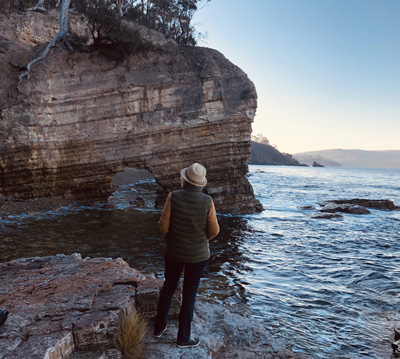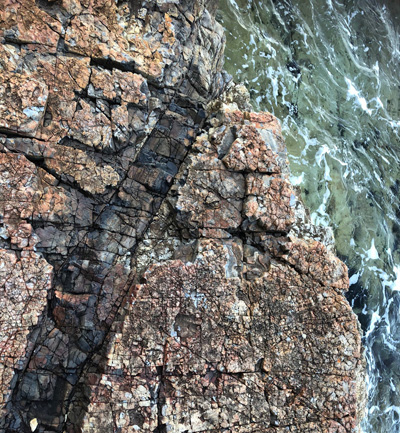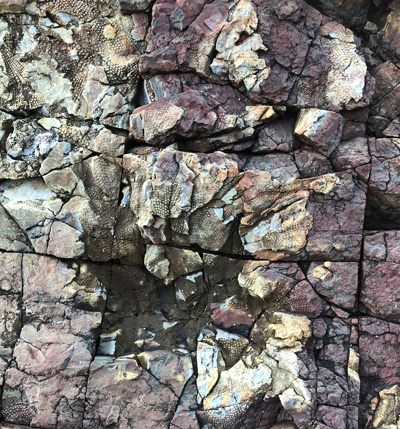During the recent lockdown period my husband and I did a lot of walking around our local area. There’s plenty of walks in Kingborough and our local Council website has a handy list of ‘Tracks and Trails’ to provide inspiration. When the restrictions on walking in national parks and reserves lifted on 11 May it was great to expand our repertoire a little more – even though we had to stay within a 30 km radius of our home.
Recently, we did the Fossil Cove walk, late in the afternoon on a sunny day. It’s only a short track (one km return) and we hadn’t done the walk for a few years – husband is usually focused on longer walks so he can ‘get his steps up’. We’d already done a walk in the morning so the outing was just an excuse to enjoy a bit more of the late Autumn weather.
The walk starts at the end of Fossil Cove Drive, off Tinderbox Road, around a few bends from Blackmans Bay. It’s well maintained by the Tasmanian Parks and Wildlife Service and a pleasant walk all the way, despite involving a steep ascent back up again from the cove. Husband was gleeful it was an opportunity to get ‘some more staircases up’.

The beginning of the walk takes you through dry sclerophyll forest, down winding steps and a gully to a final set of stairs, which descend to a small pebbly cove. Straight ahead is a wonderful sea vista, and to the right, a series of rock platforms and skewed rock faces. On the left, the cliff has a sea arch at its base, which you can walk through at low tide for more adventures on the other side.
The cove was in shadow when we arrived. It was also high tide so a walk through the sea arch to the pebbly beach beyond wasn’t possible. The sun, however, was illuminating the sea, the swaying kelp and the view beyond of the Iron Pot, South Arm, the Eastern Shore, and silhouetted headlands and bluffs back towards Blackmans Bay and beyond. All rather magical.
It’s amazing to find so many fossilised shells, algae and sea life on the square-jointed rock platform and in the many-coloured seams and textured face of the cliff. Rediscovering the myriad of fossils kept us fascinated for some time. I felt like we were exploring caches of Earth’s long hidden treasures. I was reminded that this is similar to how I felt on my first visit to Drip Beach (south of Cygnet, near Lymington) where we found a bounty of beautifully rounded lace agate pebbles on the beach and embedded in its sandy banks. We are lucky to have such places of geological wonder in southern Tasmania.
As we headed back up the stairs, we commented on the small she oak at the back of the cove, which has had its branches threaded with shells from the cove. It made me think about the Aboriginal people of the South East Tribe who would have come to this cove for thousands of years and regarded it as a special place too.
Fossil Cove is a site of National Geological Significance. The cove dates back 250 million years and provides evidence for two different geological events. It’s a great place to take kids old enough to climb up a few staircases without complaining too much.
 |  |
Take a magnifying glass to keep them busy examining the fossils up close and make sure you check the tides and plan a low tide visit. Walk notes are available on the Kingborough Council website (search for ‘Fossil Cove’ on the site).











